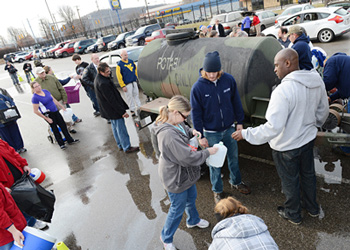

Vol. 78/No. 3 January 27, 2014

|
| Getty Images/Tom Hindman |
| After residents of Charleston, W.Va., spent hours waiting for water truck Jan. 10, supply ran out in 20 minutes. Freedom Industries never reported 7,500 gallon leak of toxins into water supply. |
“We can’t drink the water, we can’t cook in it, we can’t brew coffee, we can’t brush our teeth, we can’t wash our clothes,” said Kirk Bentley, a surface miner, by phone Jan. 12 from Madison in Boone County. “All we can use it for is flushing the toilet. We can’t do the dishes, so we had to go out and get a lot of paper plates and plastic forks and knives. It’s a major inconvenience.”
Boone is one of nine counties affected by the water ban Gov. Earl Ray Tomblin ordered. Schools shut down, restaurants closed, hotels canceled all reservations. Workers lost several days of wages. On Jan. 13, the ban began to be gradually lifted, but many will be without water for several more days.
On the morning of Jan. 9, the West Virginia Department of Environmental Protection responded to complaints about a licorice-like odor from residents near a chemical storage site. When inspectors arrived at the plant they saw chemicals leaking from a ruptured tank. A concrete block dike, meant to serve as a secondary containment, also let the chemical spill through into the Elk River.
Up to 7,500 gallons of 4-methylcyclohexane methanol (MCHM) leaked into the river, a mile upstream of the intake pipes for the West Virginia American Water Company. MCHM is used to separate sellable coal from waste material attached to it.
Freedom Industries, the owner of the plant, processes and stores chemicals in 14 shoreline tanks 2.5 miles upstream from downtown Charleston, the state capital. The company had not reported any leak or accident. It took more than a day before the bosses held a 10-minute-long press conference Jan. 10, claiming they were focused on cleaning things up. They have made no comment since. The public relations firm they hired dropped them as a client Jan. 12.
‘It’s a wake-up call’
“We haven’t really had much information about the chemical involved and how much has actually spilled,” Bentley said. “It’s a wake-up call, we’ve got to be careful with our water, we can’t live without it. I don’t like what’s happening. I haven’t heard much about health effects yet, but I’m sure that will come.”“There’s not much known about this chemical,” Elizabeth Scharman, director of the West Virginia Poison Center, told the Charleston Gazette Jan. 10. She said it could cause respiratory problems, burning of the eyes and skin, and prompt vomiting and diarrhea.
Only 200 of 84,000 in the federal Environmental Protection Agency’s inventory are tested for effects on drinking water and other water quality.
By Jan. 12, 169 patients had been treated and released from area hospital emergency rooms, according to the West Virginia Department of Health and Human Resources. Ten were admitted for further observation.
“The valley where Charleston is situated is called ‘chemical valley’ because of all the chemical plants there,” Cindy Rank, chair of West Virginia Highlands Conservancy’s mining committee, told the Militant Jan. 13. “They are all located on river banks. There have been lots and lots of problems just in recent years.”
In August 2008, two workers were killed after an explosion in a plant owned by Bayer CropScience, situated near Charleston on the Kanawha River. For several hours managers refused to tell emergency personnel the nature of the blast or what toxic chemical it released.
The plant produced methyl isocyanate, the same chemical that caused the industrial disaster in Bhopal, India, in December 1984 that resulted in the deaths of 15,000 people.
In January 2010, DuPont Corp.’s chemical manufacturing plant in Belle had three serious gas leaks within 33 hours that killed one worker when he was exposed to phospene, a gas used as a chemical weapon in World War II.
Following the Bayer plant leak the federal Chemical Safety Board issued a report in January 2011 with proposals for a new “Hazardous Chemical Release Prevention Program.” The board repeated the proposals in September that year in a report on the DuPont leak.
In June 2011, the state’s departments of Environmental Protection and Health and Human Resources decided not to implement them. Industry groups, including the American Chemistry Council, said they would “create unnecessary redundancies, as well as the imposition of additional economic burdens on local industries, communities and state governments.”
Related articles:
Capitalism threatens soil and worker
Front page (for this issue) |
Home |
Text-version home